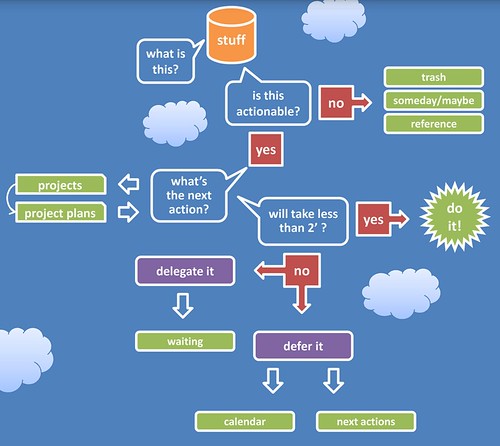So along with the massive pile of
everything in my inbox, I now had a massive pile of guilt. I had written down all of the stuff I knew I needed to do. And now it was in black and white. On paper. I could no longer hide from it. There were church members I needed to visit, people I needed to have uncomfortable conversations with, and interests who needed to be "followed-up."
My gut reaction was to just chuck the whole GTD "processing my inbox" junk and just do those things nagging at me. "Okay, okay. I'll do it already!" But I had to make a conscious decision to choose the important over the urgent (ala Covey's Seven Habits). I resolved to process my inbox.
It took me only three days to go through 6 years of accumulated junk.
I would pick up a piece of paper (book, CD, article, etc.) and ask, "is it actionable?" If not, I would file it, throw it away, or put it on my someday/maybe list. I became ruthless. It turns out a bunch of stuff was just waiting to be thrown away.
But most of it had to be filed for future reference. Pull out a file folder, type up a label on my
nifty label printer, recite the alphabet under my breath, and FILE!
If it was actionable, I would figure out if it was a one-step action or a multi-step process. If it would take more than one step to complete, I would put it on my "Project List," figure out the one next step, and put it on my action list. If it was just one step, it would go directly on my action list.
Could that next action be done in
less than two minutes? Yes? I would do it immediately. If not, I would just leave it on my action list, decide to delegate it, or put it in my
tickler file to do on a specified later date.
The two minute rule rocks! That's what allowed me to ever get to the bottom of my inbox. I would take two minutes to look through a magazine, and see if there was anything I wanted to clip or keep. I would take two minutes to look at a catalog before throwing it away or filing it. If I tried to actually
do everything before I went on to the next thing, my inbox would still be 8 feet tall.
David Allen says that two minutes is the productivity threshold. It's about how long it takes you to determine whether you'll need something and then file it.
In the process, I learned that I underestimated two minutes (badly). I would think, "Oh, I can call my church treasurer and find that out in about two minutes." WRONG! Thirty minutes later, you're still sitting there on the phone listening to them tell you about their Aunt Dorothy's cat, who has mysteriously taken ill. So sending e-mail became my "two-minute-rule" new best friend.
Three days after I began, my office was completely transformed. I had an empty inbox, a beautiful filing system, a small stack of articles for later reading, a list of things to delegate, a project list, a someday/maybe list, and an action list (which I would later divide into contextual action lists).
And for the second time in six years (the first time was that vacation with my wife in Playa del Carmen), I felt completely unstressed.
Labels: GTD, Processes, Time Management




